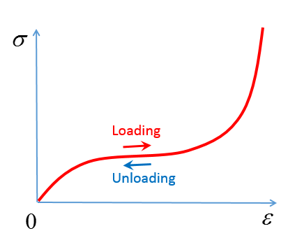Hyperelastic Materials
Hyperelastic materials are used to model materials that respond elastically under very large strains. These materials normally show a nonlinear elastic, incompressible stress strain response which returns to its initial state when unloaded.

Figure 1.
Hyperelastic materials are a specific case of Cauchy material where the stress only depends on the current deformation. Meyer’s kinetic theory describes how these materials consist of flexible chain like structure which rotates and straightens when deformed. This led to the theory that a strain energy density function could be written as a function of the deformation. 1 The strain energy density can then be differentiated to obtain the stress strain behavior of the material.
- The material is nearly ideally elastic and deformation is reversible with stress being a function only of current strain and independent of history or rate of loading, if deformed at constant temperature or adiabatically.
- The material incompressible and strongly resists volume changes. The bulk modulus which is a ratio of volume change to hydrostatic component of stress is comparable to that of metals.
- The material is very weak in shear with a shear modulus 10-5 times small than most metals.
- The material is isotropic its stress-strain response is independent of material orientation.
Element Property Recommendations
When using hyperelastic material laws, there are some recommended element property settings. When using solid elements, it is always better to mesh with 8 node /BRICK elements, if possible. If not, then /TETRA4 or /TETRA10 elements can be used. Recommended /PROP/SOLID for 8 nodes brick are, Ismstr=10, Icpre=1, with Isolid=24. If hourglassing occurs, then Isolid=17 with Iframe=2 can be used.